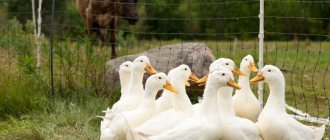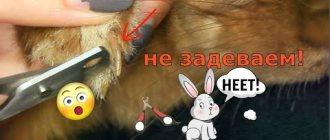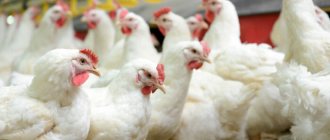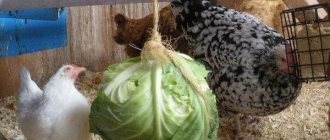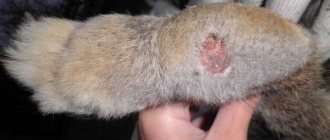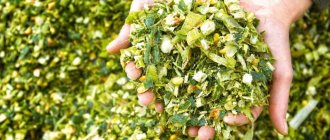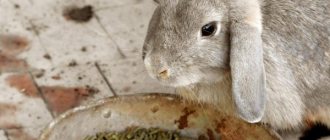Anyone who has a place in their garden at home can keep rabbits to subsequently use the meat for food. These animals are not too demanding to care for and take root easily. It is not difficult to get food for them. It will be enough to devote some 1-2 hours a day to rabbits, and as a result you will get the most tender and delicious meat with dietary qualities. The product is easily digestible, is well digested by the human body, and is recommended for use by children and people on a prescribed diet.
You can have just a few females, which will subsequently produce up to 70 rabbits per year. And this is on average up to two kilograms of meat product. If you have space, you can breed rabbits not only for yourself, but also for later sale. Rabbits eat not only plant foods, but also offal, everything that is unsuitable for humans.
Fattening rabbits for weight gain
For fattening, rabbits are separated from their mother at 2 months of age.
After depositing, they are given a diet that will meet their nutritional needs and stimulate rapid weight gain. The following products must be included in the diet of fattening rabbits:
- concentrated feed;
- grain-legume mixtures;
- boiled potatoes, corn, cucumbers, tomatoes;
- potato tops;
- wheat bran;
- cakes and meals (sunflower, soybean, flaxseed);
- mixtures - “mash” (for example, a mixture of bread soaked in milk with boiled potatoes and food vitamin-mineral premixes has a good effect on growth and weight gain).
Experienced rabbit breeders, in addition to proper nutrition, recommend using some additional methods that stimulate weight gain in rabbits: • Seed animals according to physical characteristics (strong and weak separately). • Place young animals for fattening in small cages (inactivity promotes muscle gain). • Make sure there is always food in the feeders. • Arrange an “artificial night” in the cage - darken it (eared animals eat more often and more at night).
Amount of feed for fattening
The composition of the combined feed (compound feed) contains several types of food simultaneously. This is mainly grass or pine flour, bone or meat and bone meal, cereals, vitamins, mineral mixtures, bran, cakes. The proportions of products depend on the purpose for which they are introduced into the eared menu.
For rapid growth and weight of rabbits, feed K 93-1 is used
Composition of K 93-1 and their proportions:
- Herbal flour – 40
- Ground corn or barley – 30
- Wheat bran – 5
- Sunflower (linseed, soybean) cake – 10
- Yeast – 2
- Ground peas – 8
- Molasses – 2.5
- Meat and bone meal – 1.4
- Feed phosphate – 0.8
- Table salt – 0.3.
The daily amount of feed depends on the age of the animals, breed and physiological characteristics of the body - from 60 to 180 g per day per rabbit.
How long does it take to fatten rabbits?
Fattening rabbits lasts from 90 to 180 days from the date of birth, taking into account the breed.
| Breed name | Age for slaughter |
| Californian | 100-120 days |
| New Zealand | About 120 days |
| Soviet chinchilla | 150 days |
| White pannon | 90-120 days |
| Flandre Risen Gray giant White giant | 150-180 days |
Rabbit breeders' advice
Rabbit breeders on their farm use tricks that help fatten the animal well.
- During fattening, rabbits are divided into groups, which include separate males and females. They also pay attention to the same age and starting weight. Only in this case can you know with confidence that everyone will receive the same amount of food, since in such cases the strong will not take it away from the weak.
- The farm uses small cages in which rabbits are placed for fattening. They are provided with free access to it. The smaller the cage, the less the animal moves, which leads to good weight gain.
- Locomotor activity in rabbits occurs more in the evening; during the day they are calm. Rabbits have their cages darkened during the day to increase their appetite.
Mini home farm format
To build your own small farm, first of all you need to find out from the local administration how far the farm should be from residential buildings. This knowledge will help you avoid getting fined in the future.
Small hillocks are considered the best place for construction. During rainy summer-autumn periods, and when the snow melts in spring, water will not accumulate. As we wrote earlier, rabbits do not like high humidity. The best option would be to concrete the area.
The area of the site must be at least 700 m2 and have an uninterrupted power supply.
Three necessary structures need to be built on the site:
- Shed system (cages for rabbits)
- Refrigeration and slaughterhouse space
- Utility room
- Well for water supply
In mini-farms, caring for and maintaining rabbits takes a small amount of time and does not require much effort.
Other content methods
There are other technologies for keeping rabbits, among them you can choose the one most suitable for your purposes.
Aviaries
Aviary maintenance will not require large expenses, and the conditions are as close as possible to natural ones. To protect against undermining, you can dig a fence made of poles, slate or mesh around the perimeter to a depth of 60 cm or more. In enclosures, bedding is necessary, but it is changed much less frequently. A third or half of the enclosure should be covered with a canopy, under which there are drinking bowls and feeders.
Sheds and minifarms
Sheds are individual cages that are arranged in a row in tiers. They are equipped with removable pallets or bunker boxes, which are installed separately on 2-3 stands, which makes cleaning easier and faster.
Mini-farms are built from shads, in which up to 1000 heads can be kept. In such farms, rooms with shads are equipped with heating and additional ventilation. This is the most modern, convenient and effective method of keeping and raising eared pets, but it is also the most expensive. Therefore, it is mainly used for large rabbit farms.
Feed stocks
The basis of the rabbit diet is 4 products:
- Hay.
- Fodder beet.
- Barley.
- Green mass.
Greens are available for consumption only in the spring and summer; in cold times, hay and vitamin food supplements will make up for their absence. The grain component is necessary all year round, since raising rabbits at home is only possible if high-calorie food is available.
It is possible to raise livestock on compound feed, but such feeding of rabbits at home is practiced by novice breeders, while experienced farmers use compound feed only when they have a very large number of animals.
When raising rabbits in the village, most of their food is obtained naturally: hay is mowed, beets are grown on the plot, and greens are picked in the surrounding areas. For a herd with 5 breeding females, it is enough to purchase 2 tons of oats per year, most of it is consumed by fattening animals and the breeding male. Mother rabbits are also given oats, but in smaller quantities, since it is not possible to raise rabbits at home with the help of well-fed females; they may have problems with reproduction.
Table 2. Feeding table adopted in the project
| Rabbit diet, g | summer (June-September) | winter (January-May, Oct., Nov., Dec.) | |||||
| grass | concentrate | sol/mel | hay | juicy feed | concert | sol/mel | |
| Fattening rabbits | 700 | 70 | 1 | 150 | 500 | 100 | 1 |
| Male and female rest | 650 | 30 | 1 | 150 | 150 | 40 | 1 |
| Male during mating period | 800 | 40 | 1 | 150 | 200 | 55 | 1 |
| The female is pregnant | 800 | 45 | 1 | 175 | 200 | 60 | 1 |
| Young female brood | |||||||
| age 4-7 months | 900 | 55 | 1 | 250 | 300 | 70 | 1 |
| Sucker females | |||||||
| First half of suction | 1200 | 65 | 1,5 | 200 | 350 | 87,5 | 1,5 |
| Second half of the suction | |||||||
| add. for each little rabbit | 80 | 6 | 12 | 30 | 7 | ||
| Young animals | |||||||
| 1-2 months | 300 | 40 | 0,5 | 70 | 150 | 50 | 0,5 |
| 2-3 months | 400 | 50 | 0,5 | 70 | 200 | 60 | 0,5 |
| 3-4 months | 600 | 80 | 0,5 | 120 | 250 | 90 | 0,6 |
| 4-5 months | 700 | 90 | 0,5 | 135 | 300 | 100 | 0,6 |
What do rabbits eat at home: vitamins, minerals
It is extremely important for these animals to receive sufficient amounts of vitamins, especially during cold periods. Fish oil is very important for them, which is dosed as follows:
- for babies - 0.5 g per individual;
- for an adult animal - 1.5 g;
- for pregnant and lactating females - 3 g.
Culinary yeast and hay are rich in vitamin E, and it is also found in sprouted grains. And from ordinary chalk, an animal can get a sufficient amount of calcium.
Table salt is very important for animals, which must be given to them in the following ratio:
- babies - 0.5-1 g;
- adults - 1.5 g;
- lactating females - 3 gr.
Costs and profits
Breeding and keeping rabbits has a great advantage, which is their fertility.
One female, with good care, can handle 10 litters per year. And this is 50-60 cubs from one rabbit. From 60 female rabbits it is possible to get 3600 female rabbits. This is 7200 g of meat. If you sell meat at 300 rubles per kg, you can earn 2,160,000 rubles a year. 50% of the profit goes to necessary expenses:
- Feed;
- fare;
- electricity;
- salary for hired workers;
- purchase and routine repair of cages;
- veterinary expenses (plus vaccinations).
If you work without hired workers and carry out vaccinations yourself, costs are reduced.
Staff
A rabbit breeding farm requires the constant work of an entire production team:
- Operator worker, 1 person. They are engaged in servicing the rabbit population, monitoring the vital activity and health of individuals.
- Worker for slaughtering rabbits and packing meat, 1 person. Kills animals (possibly using electric current), cuts up products, packages them, packs them, puts them in refrigerators. The remaining 2 positions can be outsourced.
- Veterinarian. Manages the organization and implementation of all sanitary and veterinary measures, advises workers.
- Engineer. Monitors the serviceability of equipment and carries out repairs.
You may also need the services of an electrician, a cleaner, an accountant, or a driver for delivering meat.
Drinking fountain
Such a device can serve not only to quench the thirst of animals, but also become an original accent in the home interior. The design consists of a water bowl, a filter, a diffuser and a drinking bowl located at the top. Additionally, it is equipped with a decorative sprinkler, especially popular with native breeds (Maine Coons, Kuril Bobtails, Siberian cats).
Continuous circulation of liquid is ensured by a mini-pump powered by a USB cable. More advanced models may contain backlighting and an indication of the level of remaining water in the tank.
Cost – 2400 rub.
Soft bag
Fabric carriers have been around for a long time, but their modern development has primarily affected the increase in the number of all kinds of windows, mesh and other little things. The cat will no longer sit in a dark bag, not much different from an ordinary travel bag. It is difficult to organize a comfortable long trip in such a device. But for short distances the convenience is quite adequate.
The advantage of a soft cage is its lightness, compactness, and the ability to securely attach it to a car seat or, for example, to the handle of a suitcase.
Negatives: Not hygienic for long trips and difficult to clean quickly (although they can withstand washing in a regular washing machine).
Cost – 1,360 – 1,489 rubles.
The difference between factory feed and natural feed
Every livestock breeder should know what to feed a decorative rabbit. In stores, consumers are offered a large selection of different feeds. They are rich in vitamins, microelements, and acids. But if you feed animals exclusively with commercial food, they will quickly begin to gain weight. Therefore, it is often prohibited to give this type of food. With daily consumption of dry food, the pet will begin to refuse natural food. And this type of nutrition must be present in the diet. Therefore, purchased food should be given in limited quantities. Experienced livestock breeders recommend giving them to animals as a reward or treat. It should be noted that eared animals are herbivores. Mixtures of dry fruits, grains, and nuts are undesirable for them. Properly selected high-quality feed contains 20% unrefined fiber, 1% calcium and fat, 15% protein.
Selection of rabbits for the tribe
We select young rabbits for the parent herd based on pedigree - we take young animals from the best parents, and in addition, we select the best in terms of growth and development. We select rabbits in two stages. The first time we evaluate candidates for the breeding core is at the moment of weaning from the female rabbit. We carry out the second selection 20-30 days before the planned mating of young females.
Replacement female rabbits and female rabbits selected for reproduction and rejuvenation of the herd are kept together for up to 4-4.5 months. Then we transplant the rabbits to a permanent place in individual cages, and place the rabbits in group cages until they reach the age of 10-11 months, until their first mating. After successful mating, we provide young rabbits with individual cages.
We carry out the process of rejuvenation of the herd constantly. The structure of the herd of queen rabbits is approximately as follows: 35-40% are young rabbits of the first year of use (second year of life), 40-50% are female rabbits of the second year of use (third year of life), and 15-20% are female rabbits of the third year of use ( fourth year of life). Sometimes we use the best females for the fourth year. In the population of breeding rabbits, the majority are young males of the first year of use (second year of life) - 45-60%, rabbits of the second year of use (third year of life) make up 20-40%, third year of use (fourth year of life) - 15- 20%.
We evaluate all the livestock selected for the tribe and conditionally divide the males into two groups - the best and average, and the females into three groups - the best, average and worst. Crossbreeding is carried out according to the principle: the best with the best produce replacement young stock; the best with the worst - the offspring go to fattening; average with average - from such pairs the best rabbits will go to breeding, the rest for fattening.
Basic aspects of raising rabbits for meat
After giving birth, females often lose weight. To achieve the required weight, the rabbit can be quickly fattened by adding branches of coniferous trees, ordinary wormwood, and caraway seeds to the main diet. Dill increases the animal's appetite, and at the same time it is necessary to increase the amount of grain crops and bran.
Oats and wheat can be given either raw or in the form of porridge. The body absorbs boiled foods faster. It is worth remembering that dry food and cereal cannot be alternated; one of two types of feeding is chosen. The weight of a meat breed rabbit should not be less than 1.9 kg.
What a monster! And how much meat!
There is a fatness standard for meat rabbits:
- Animals with good fatness, developed muscles, and a good layer of fat belong to the first category. Also, the spine of such rabbits cannot be felt.
- Animals with a weak layer of fat, a prominent spine and retracted hips belong to the second category.
In general, to quickly gain weight, your rabbit will need the following:
- cereal crops (barley, wheat and others);
- cake;
- compound feed;
- meat and bone meal;
- bran;
- leaves and shoots of trees;
- soy;
- flax-seed.
Rabbit on the scales
Feeding rules
- Cleanliness and hygiene
The food must be clean, free from dirt, mold and other harmful substances. All these substances pose a threat to animal health.
- Freshness
Green food should be fed only in fresh form, waste bread and the like - only in dry form.
- Remove leftover food
Distribute the amount of feed that will be consumed before the next distribution.
- Good quality hay
- Fresh water
The daily water requirement of rabbits (in ml) is equal to the amount of dry matter eaten (in g) multiplied by 3, in ml. Lactating females should have free access to water at all times, as they have a particularly high water requirement. The water must be clean and changed at least once a day (if nipple drinkers are not installed).
The feeding rates given are valid for medium-heavy breeds or hybrids, in which the weight of an adult rabbit is about 4 kg. For heavier animals, diet adjustments are necessary, as indicated below.
For lighter breeds up to 30% less. For heavier breeds – up to 30% more. If there are signs of obesity, reduce the amount of concentrates
Preparation of necessary documents
In the rabbit farming industry, it is mandatory to register your business. You can register your business in three ways: Peasant farm (peasant farm), and individual entrepreneur (IP) and personal subsidiary plot.
- Peasant farm. The advantage of this form of ownership is state support in the form of subsidies and preferential conditions. With this registration, you will act as an individual entrepreneur, but with a limited list of rights. It includes only that category of people who have the right to any economic activity. If you run a medium-sized business focused on domestic rabbit breeding, then this form will suit you perfectly.
- Individual entrepreneurship. This is a simple and convenient form of doing business with a large list of possibilities. You can easily move from a small farm to a large livestock complex. In taxation, you can use the unified agricultural tax or a simplified system.
- Personal subsidiary farming. This is the most economical design option in this business. It has the advantage of no taxation on the sale of meat. To obtain this status, you only need to provide a certificate of ownership of a summer cottage. You can get it from compulsory medical insurance. However, if you are planning rabbit breeding on a large scale, then this type of design will not suit you. You will not be able to sell your product in hypermarkets and restaurants, and there will also be a limit on the quantity of products sold.
To obtain a sales permit, you need to prepare the following package of documents:
- Sanitary book
- Certificates from a veterinarian confirming the absence of diseases in rabbits
- Certificates from laboratories where the tests were carried out
- Sanitary certificate of a vehicle for transporting rabbit meat.
The rabbit breeding business involves the purchase of equipment for keeping rabbits. There are three main ways of keeping them: semi-free, aviary and the most common - the cage system. The cellular system is the most convenient for maintaining veterinary requirements and sanitary standards.
Broiler feeding
This type of meat production is very common and is often used in large livestock complexes. Broiler fattening involves keeping young animals with their queens until slaughter. Nutritious milk from rabbits promotes rapid weight gain in young animals, while the female can be coated again almost immediately after giving birth.
The main advantage of this technique is cell saving.
It is important to know. With intensive feeding of young animals, the females become severely exhausted, and therefore they need to be given an increased amount of feed so that the milk does not disappear and disturbances in reproductive function do not occur.
Frequent feeding of offspring in violation of sanitation standards (this also happens on some farms) leads to the fact that females begin to suffer from diseases affecting the mammary glands.
It is worth noting that the skin products of broiler rabbits are not of particular value (unlike meat products). The following breeds of rabbits are suitable for this feeding method:
- white giants;
- silver;
- Soviet chinchillas.
All of the above groups are precocious and are able to quickly gain weight while the female feeds them. The average weight of 42-day-old rabbits is about 2-3 kg.
During the lactation period, the female should receive 50% (no less) of concentrated feed in the summer and about 60% in the winter months. Rapid growth of young animals will be achieved if animals can receive 150 grams of protein from one unit of feed. It is recommended to use legume hay for feeding, which contains vitamins and is highly nutritious. As for water, rabbits should have it freely available at all times.
Nutritional supplements for artificial weight gain
To accelerate the gain of live weight, farmers use growth stimulants. This is a complex of vitamins and biologically active substances, the effect of which is manifested as follows:
- strengthen the body;
- improve feed digestibility;
- speed up metabolism.
Additives are added to the grain mixture that is fed to animals. The following growth stimulants are popular:
- Phos-Bevit - accelerates cell growth, normalizes metabolism, increases body tone;
- Nucleopeptide and Flavomycin - help food to be fully absorbed;
- E-selenium - regulates metabolism, protects the body from toxins and stress.
Phos-Bevit
E-selenium
Nucleopeptide
There are also standard sets of vitamins and premixes that have a general strengthening effect on the body: Chiktonik, Eleovit, Ushastik, Eshka, Zdravur. It must be remembered that complete feed for rabbits already contains vitamins and minerals. An overdose of nutrients leads to hypovitaminosis.
Features of winter nutrition for weight gain
Winter is the time of year when animals must meet their energy needs to heat the body. If you feed rabbits for meat, then during this period it is worth doing it more intensively.
| Percentage of feed in the winter diet: |
| Hay 30% |
| Compound feed 40% |
| Juicy feed 20% |
| Concentrates 10% |
| With 3 times feeding in winter | With 4 times feeding in winter | ||
| Time | Dosage | Time | Dosage |
| 9-00 | Half of the daily volume of hay and concentrates | 6-00 | A third of the daily norm of concentrates + a quarter of the norm of hay |
| 13-00 | Juicy feed | 11-00 | A third of concentrates + half of succulent feed |
| 18-00 | Half daily intake of concentrates and dry food | 16-00 | Half juicy food + half hay |
| 19-00 | A third of concentrates + a quarter of the norm of hay with branches |
Adding ground pears and potatoes to your diet has a positive effect on weight gain.
When to slaughter
To get high-quality dietary products, you should listen to the following recommendations:
- The meat of animals that have reached the age of 7 months is most valued; this period allows farmers to significantly save on the amount of space on the farm and the feed supply;
- to get better quality meat, it is recommended to castrate males 14 days in advance (before starting to fatten rabbits before slaughter);
- in the fattening shop it is necessary to establish a limited light regime;
- feed containers must be filled at all times, and clean and fresh water must be present in drinking bowls.
Vienna Blue breed
Rabbit meat contains vitamins and minerals, it is recommended for baby food, women during breastfeeding and people engaged in extreme professions. Rabbit meat is well absorbed by the human body, regulates fat metabolism and balances nutrients.
We invite you to join our Zen channel and group on VKontakte or Odnoklassniki, where new articles are published, as well as news for gardeners and livestock breeders.
Similar articles:
- Breed overview: Russian ermine rabbit
- Coniferous branches in the winter diet of rabbits
- Should you give zucchini to rabbits?
Diseases
The body of rabbits is quite delicate and does not have a strong immune system. For this reason, they often pick up various infections. Transmitted from rabbit to rabbit, diseases very quickly affect the entire flock. Typical symptoms of an infectious disease in a pet include:
- lack of appetite;
- body temperature is more than 39 °C;
- discharge from their eyes and nose;
- stomach upset;
- patchy dull fur.
Infectious infections in rabbits cannot be treated. When the first symptoms are detected, the sick animal must be removed from everyone. But this measure does not always protect the flock from death. The best way to prevent infection is timely vaccination.
Profitability of raising rabbits for meat
First you need to determine for what purpose you are getting rabbits. If you are just starting to breed them, then it is more profitable to take well-known local breeds.
The profitability of raising rabbits is determined by several factors (Figure 6):
You need to purchase healthy, active individuals, with a well-fed, well-built body, clean eyes and shiny fur. Animals with elongated heads, floppy ears, sagging backs and bellies, and balding hair are considered unsuitable. You need to take care of the housing for the livestock in advance. For outdoor keeping, cages with two compartments are equipped. Feeders and drinkers are fixed inside. Indoors in winter, cages with double ceilings and thick walls are insulated. Cages can be made of different materials, but there should be no drafts in them
It is important to ensure a constant flow of fresh air and optimal daylight. The cells are arranged in several tiers with a passage between them and moderate lighting. When raising rabbits for meat, the light intensity is reduced for the fattening period.
Then choose a maintenance method that will suit your conditions. If there is not enough space on the site, but there is a basement or cellar, then you can keep animals using the pit method.
Rabbit meat is a quickly digestible, high-quality product containing a lot of protein. It is recommended for children, athletes, women during pregnancy and lactation.
Figure 6. Calculation of the profitability of rabbit breeding
When raising rabbits for meat, profit will be brought by meat breeds with rapid growth, weight gain, good quality products, as well as representatives of the meat-skin direction of productivity.
All carcasses must comply with approved GOSTs and quality standards. After slaughter, carcasses are cleaned of all internal organs except kidneys. The head is separated at the first cervical vertebra, the hind limbs at the hock joint, and the forelimbs at the carpal joint (Figure 7).
Rabbit carcasses are usually divided as follows:
- Cooled - temperature no more than 25 degrees;
- Chilled - from 0 to 4 degrees;
- Ice cream - no more than 8 degrees below zero.
To sell rabbit meat, it must be frozen or refrigerated. It is not allowed to sell carcasses to retail chains if they have the following defects:
- Bone fractures;
- Back fat takes up more than a third of the total length of the carcass;
- Cleaning up bruises or bruises;
- Carcasses that were frozen more than once, after which the color changed (became flesh-colored).
During marking, each carcass is marked with a mark on the outer side of the drumstick: carcasses of the first category are given a round mark, carcasses of the second category are given a square mark, and broiler carcasses have an oval mark. If the carcass does not meet the requirements, a triangular mark is placed on the back. From the video you will learn basic recommendations for fattening rabbits for further sale for meat.
Business plan "rabbit farm"
To benefit from rabbit breeding, a business plan is drawn up that considers the main aspects of rabbit farming. A farmer needs to become an individual entrepreneur, since this form of ownership reduces taxes and makes accounting easier.
Figure 7. Cutting a rabbit carcass
The profitability of raising rabbits for meat is average, since this product is not considered the most popular on the market. Fattening animals for meat as a business includes several preparatory stages.
First of all, you need to select a plot of land. A profitable option would be a plot with a minimum rent. The next step is purchasing cells. By building them yourself, you can save your money. At the third stage, you should purchase rabbits. And also hire an employee who will take care of the animals.
The organization of sales must be thought out before starting the organization of the economy. Clients can be meat markets, supermarkets, and individuals. The skins can be sold to fur studios and private fashion designers.
Selection of roughage
It has already been said above that the rabbit’s diet must be varied. One feeding option is roughage. In this case, various herbs, dried straw, and thin tree branches are suitable. One of the best candidates for this type of food would be hay, because it contains a large amount of fiber, which significantly improves digestion in rabbits. Making hay is quite simple; to do this, you need to mow the grass (manually or using special equipment), preferably in a meadow where a huge number of all kinds of useful plants grow - clover, chamomile, alfalfa, peas. When collecting grass, you should mow it before flowering and carefully ensure that you do not come across plants that are poisonous to rabbits (celandine, dope, wild mustard). After everything is mowed, the harvested crop is quite simply dried in the sun, collected into sheaves and food supplies are ready.
Hay harvesting should be done at the rate of approximately 45 kg of hay per adult for wintering. It is better to store hay under a canopy, providing good ventilation, but at the same time so that it does not get wet or collect moisture. In addition, it is worth noting that hay is a fairly nutritious product, which is an important aspect when fattening rabbits. It is best to give it in late autumn and winter, when supplies of fresh grass have dried up, as well as in early spring - before fresh greenery appears. Sometimes pea or oat straw can be given instead of hay, as it contains a lot of fiber. However, rabbits do not eat it very well, and it is also poorly digestible. Therefore, it is better to give it only to adults and only on the condition that other types of food are already running out.
When you haven’t had time to prepare hay or your supplies are insufficient, another good option comes to the rescue - this is branch feed. It is considered an essential component in the diet of rabbits, and is also a fairly affordable and healthy type of food. By the way, soft twigs help rabbits grind down their teeth and avoid gnawing through the cage. To do this, you can prepare twigs from trees such as birch, linden, willow, willow, aspen, maple, poplar, ash, apple, pear, acacia, oak, alder. Branches of coniferous trees - spruce, pine, cedar - are in particular demand.
However, not all trees are worth plucking branches from. You should not give rabbits shoots of apricot trees, bird cherry, buckthorn, elderberry, wild rosemary, cherries, plums, cherries, and peach. These representatives contain toxic substances (for example, hydrocyanic acid), which can adversely affect the health of your long-eared pets. Preparation of branches should be done at the beginning of summer, cutting them off and collecting them in brooms, and also dry them thoroughly and store them in a ventilated place. In winter, if the supply of “summer” twigs runs out, spruce twigs will be an excellent option, which rabbits will eat with great pleasure. In addition, by eating branches of coniferous trees, animals' digestion improves, their fur takes on a beautiful, well-groomed appearance, becoming smoother and shiny. This type of food is universal, as rabbits can eat it all year round.
Breed directions
Do not thoughtlessly buy different types of rabbits. It is advisable to determine the initial products for yourself and, based on this, choose meat, meat-skin and fur breeds. The latter are distinguished by beautiful and thick hair.
For breeding for meat, it is advisable to buy the following species:
- New Zealand Red. The price ranges from 400 to 1,500 rubles. It is picky about food and requires regular feed, hay and various types of grass. High risk of disease even with vaccination. Average weight - 4-5 kg.
- Soviet chinchilla. Also suitable for fur breeding. They are easy to care for, and because of their warm wool they suffer less from the cold. At six months their weight is 5 kg. Price - 500-1,000 rubles.
- Californian. He eats any food and quickly gains weight. They have high immunity and low mortality rates. By 6 months they grow up to 5 kg. Market value - 300 rubles.
- A gray giant whose name speaks for itself. Resistant to disease. The carcass is very large, up to 7.5 kg. The price reaches 1,000 rubles.
- New Zealand white. The diet is standard - grass, hay, flowers and pelleted feed. They reach a weight of 6 kg. You can buy it for 500-600 rubles.
- White giants are hardy and reproduce well. Weight depends on the class and averages 5-6 kg. Compound feed is enough for nutrition, but their appetite is strong. Price - 400 rub.
- The French ram is distinguished by its folded ears and long gray hair. THEY are classified as meat, but the skins are highly valued. They are unpretentious in feeding, but require large cages or shads. The price starts from 600 rubles per individual.
It is recommended to purchase animals only at farms or exhibitions and be sure to ask the owner to show documents. Pedigree rabbits at markets are often sick.
Too low a price for an elite breed should alert the buyer, since there is a possibility of buying a purebred or very similar to a purebred.
Fur-bearing breeds include the Angora and white downy rabbits. Some meat species are distinguished by beautiful hair: polar silver, Soviet chinchilla and others. They can be bred for two purposes at the same time.
How to feed?
Rabbits are animals with an insatiable appetite. If they are healthy and the food is fresh and aromatic, then the animals are ready to chew it all day. In the summer, the problem of nutrition is solved very simply: eared animals can nibble green grass on the lawn, nibble on carrots, and will not refuse vegetable tops.
Types of winter feed
It is better to make provisions for the winter, because, as in the summer, rabbits need adequate nutrition, which includes proteins, fats, carbohydrates, and vitamins. Therefore, the diet of animals should be varied but balanced. “Winter” types of products include:
- hay (makes up 60% of the daily rabbit menu);
- branches of juniper, spruce, aspen and other trees, from which cherries, plums, cherries, and peach should be avoided (due to the presence of hydrocyanic acid, which is poison for fluffies);
- root vegetables (you can plant carrots, potatoes, cabbage with a “spare”, counting on having to feed the eared ones);
- cereals (wheat, barley, millet, corn, etc.); legumes (peas, beans, lentils, alfalfa, etc.).
Animals happily eat special mixtures that are sold in pet stores. The need for salt can be satisfied by purchasing a salt stone and placing it in the cage.
The abundance of dry food in winter requires the animal to receive a sufficient amount of water. If it is dirty and does not change for several days, the rabbits will not drink it, the instinct of cleanliness is too strong in them. Therefore, water should always be fresh, in sufficient quantity, and feeders should be cleaned daily of food debris.
Feeding rules
The number of feedings depends on many factors: on the availability of free time for breeders, on the characteristics of the animal’s breed, on their rapid or slow growth, and on age. Recommendations for the feeding process are as follows:
- Rabbits should receive their next meal at the same time.
- It is necessary to ensure that the dry grass in the feeders is always fresh.
- The minimum number of feedings is 2 (in the morning and evening, when the rabbits have a “brutal” appetite), and the optimal number is 5-6, which is very rarely achieved by breeders due to their daily busyness with other things.
- Dampness and dirt should not be allowed into the “home” of the little ears, because from such conditions they quickly get sick and die, as they say, “in batches” - both adults and children. The rabbit is sick - there is no appetite, weight is lost, and the immune system weakens. The animal dies very quickly.
- The room, which will “predispose” animals to prolong their offspring and the desire to chew something, should be well ventilated, but not subject to drafts; sufficiently illuminated, but at the same time so that the long-eared ones have the opportunity to hide in a shaded corner.
- The water must not be allowed to freeze. If rabbits are thirsty, they will chew on ice. And this can negatively affect their health. Ice must be removed from the cage promptly.
- If both food and food are in a warm state, the animal’s body will not have to waste energy on warming them, so the digestion process will occur faster, and accordingly, appetite will arise more often.
- When animals begin to be fattened before slaughter, it is better to seat them one at a time.
- You should not overuse legumes and beets. The former causes flatulence in animals, and the latter causes a weakening of the intestines.
- Potatoes are much better digestible if given boiled.
- The transition from summer to winter nutrition occurs gradually. You can’t just start feeding your rabbits hay and grain all at once.
- Portions of greens decrease day by day, then they begin to be excluded from some meals altogether.
If these points are taken into account, rabbits will eat well in winter and produce strong and healthy offspring.
Initial data for a business plan
The project initiator owns a land plot with an area of 14 acres. It is planned to allocate 4 acres for growing food for rabbits. On the same site there is a barn-type structure in which cages with rabbits will be located. The cost of building a shed is not included in the project. Electricity and water are supplied to the barn. Water comes from our own well.
To implement the project, it is planned to purchase:
– rabbits – 5 pieces,
– rabbits – 50 pieces,
– cells with queen cell – 50 pieces
In total, it is planned to spend 320,200 rubles from our own funds on the purchase of rabbits and equipment for the rabbitry. Also, funds in the amount of 150,674 rubles are required for the purchase of feed and for the initial conduct of activities. Thus, the starting costs are 470,874 rubles.
The initiator of the project decided to purchase baby rabbits of the “California” breed. This breed of rabbits has a litter of 8 to 10 rabbits
Taking into account that some rabbits may die at birth, we assume that each female rabbit gives birth to 7 rabbits. The calculation will be based on the three-bread method of rabbit breeding
Thus, if we purchase 50 rabbits for the project, we can get 1050 rabbits from them in a year.
To calculate feed for rabbits, we use table No. 2.
The costs of registering an enterprise are not included in the calculations.
German ram
One of the very “old” rabbit breeds. Obtained as a result of crossing Flanders with medium-sized rabbits of a breed such as the French ram. Another fold-eared variety, the English ram, took part in the breeding work. Since the main selection was carried out in Germany, the resulting variety was called the German ram.
The constitution of this breed is heavy, but compact. The heavy body and wide bones make these rabbits externally stocky and squat. A characteristic feature is very long and wide ears, hanging down to the sides. The large size of the broad-browed head with a characteristic hump-nosed profile makes the muzzle of these rabbits look like that of a lamb (hence the name). Also a distinctive feature of German sheep is the longer hair on the head in the form of a horseshoe, which experts call the “crown”.
In addition to silver, the breed standard allows any other coat color.
Among the advantages, experts especially highlight the high taste of the resulting rabbit meat and the good quality of the skins.
Breed German sheep
Diseases
How to breed rabbits so they don't get sick? The only sure way is vaccination, maintaining cleanliness and a well-formulated diet.
Young animals are vaccinated against myxomatosis at 28 days. The vaccination is repeated at 120 days.
Vaccination against VGBV is given at 45 days. The procedure is repeated every six months.
The associated vaccine acts immediately against myxomatosis and VGBV. It is done at 45 days. Prevention of pasurellosis is done at 2.5 months. Piperazine is administered to each animal through the mouth (0.5 g per kg of rabbit weight).
At 3 months of age, Baycox or Amprolium is given once for coccidiosis.
Weakened individuals are treated before vaccination.
Mistakes of inexperienced farmers
Beginning farmers can make mistakes when starting to raise rabbits.
The most important of them:
- the female is not taken away from her partner on time after mating;
- young males who are not capable of fertilization are used for mating;
- lack of control of the nest after birth;
- feed not suitable for rabbits;
- untimely slaughter;
- non-serious attitude towards vaccination;
- wrong choice of breed.
Raising rabbits can be a profitable family business. With proper care, the initial costs will pay off within a year, and the home business will generate good income.
Technology and methods of raising and breeding rabbits for sale
Popular breeding methods include mating rabbits of the same breed and crossing animals of different breeds. In the first option, the goal is to increase and strengthen the valuable characteristics of one breed, and in the second, to obtain new properties and characteristics.
Raising rabbits at home involves keeping animals in:
- pit,
- cage,
- aviary.
Each method has its own justified advantages and undoubted disadvantages.
1. Breeding and raising rabbits in pits
+'Advantages
- This is the most budget option for breeding animals, since this design requires virtually no financial investment.
- The litter of rabbits will be distinguished by an impressive number and good viability.
- Rabbit meat will become tastier.
- The life of animals will be more healthy and natural.)
- It is impossible to raise large breeds of rabbits and individuals with valuable fur.
- In case of serious diseases, a mass pestilence of animals will begin.
- It may be difficult to clean the pit.)
2. Breeding and raising rabbits in cages
Cages for breeding rabbits can be constructed from almost any material: wood, brick, slate, plywood. A sheet of metal, slate, board or roofing felt is installed as a roof.
The main disadvantage of cages is regular cleaning and tidying. But this particular method of raising rabbits is the most popular.
3. Breeding and raising rabbits in enclosures
Main advantages of the method
- Convenient maintenance of animals, feeding and cleaning is carried out not individually (as in cages), but en masse.
- Animal health improves significantly as rabbits are able to exercise more.
Flaws
- The need for a separate plot of land to house the enclosure.
- Increasing costs for creating a structure.
What should you not feed?
It is worth paying special attention to those foods that should not be given to rabbits under any circumstances. When giving green food, consider the list of herbs that should not get into their feeder under any circumstances: datura, henbane, crow's eye, lily of the valley, larkspur, celandine, spurge, foxglove, hemlock, mustard, nightshade, wild radish, marsh horsetail , buttercup
Each of these harmless plants can harm the health of rabbits. Some may cause bloating, for example, a lumbago may even paralyze. Therefore, you need to be very careful and attentive when collecting grass.
And when making hay, you should not mow the grass near roads and industrial enterprises. Rabbits should not be given tomato tops, and should also be fed red beets, grains and legumes in limited quantities. It is forbidden to include onions in the diet, especially for lactating females, as they can make the taste of milk bitter. Rye, millet, millet and polished rice - these products can increase the amount of mucus produced in the stomach due to their solid structure and low fiber content. Under no circumstances should you give grains raw, only after soaking them.
Although potatoes are permitted foods, they should still be given with caution. It is recommended to feed fresh potatoes to animals during the fattening period (due to the high starch content in the tubers)
In other cases, it is better to limit yourself to small portions. You should not give potato sprouts, as they contain a very toxic substance - solanine. It is advisable that rabbits eat only peeled, boiled potatoes. It is also not recommended to feed dairy products, even tiny portions. Give apples only without seeds, because they contain amygdalin, a very harmful substance.
Bread, buns, cookies and other bakery and flour products should never be consumed by rabbits. No sweets, since baked goods contain a large amount of complex carbohydrates, starch, and yeast, which in turn can lead to obesity. The only time when it will be possible to add these products to the diet is during the final fattening period, immediately before slaughter. Prohibited foods also include seeds, nuts, mushrooms, cauliflower, and chocolate. Under no circumstances should you take risks and give cat food.
For information on what to feed rabbits at home, watch the following video.
Down breed business
When choosing animals for breeding, you need to pay attention to the amount of fur. There should be a lot of it on the sides and stomach, on the head and limbs
The length of the fur should be at least 6 cm with a small spine.
Downy rabbits are kept in closed enclosures in groups of 10-15 individuals. 4 animals are placed in smaller cages. In the cold season, you will need a straw bedding. Bedding is also provided for female rabbits before giving birth.
Downy rabbits, compared to meat-skin rabbits, have an increased need for protein - it is necessary for good down formation. Therefore, special requirements are imposed on the feed: it should not consist only of cereals, it is necessary to add meal, cake, bean grains, meat and bone meal. The amount of feed is 15% more than that of meat and skin breeds.
Down is collected by plucking - this is the most common method. They start from the back, be sure to leave some amount of fluff so that the rabbit does not freeze in the winter, which can lead to illness and even death. They begin collecting fluff at the age of 2-2.5 months; the length of the fur should reach 5-6 cm. The delicate fluff of young individuals falls off easily, which requires some skills in work. The second collection is carried out at the age of 4-4.5 months, the third - at the age of 6-6.5 months. In adult rabbits, fluff is plucked regularly once every one and a half to two months.
Useful tips
The productivity of downy rabbits increases if you add a little cobalt chloride (1-1.5 mg per individual) to the feed once a week. The powder is dissolved in water and mixed with food. This should be done at the very beginning of collecting fluff. Instead of cobalt chloride, you can use cobalt nitrate, the effect of which is no different. To prevent the fluff from falling off during storage, it is placed in tightly closed boxes measuring approximately 80 x 50 x 50 cm. About 6-7 kg of fluff can be placed there. Pegs with a height equal to the height of the box are nailed to the bottom at a distance of 10-12 cm from each other. Place bags with mothballs to prevent moths from appearing, or with lavender flowers. New rabbits, just purchased to increase the number of livestock, are placed separately from the rest for at least a month.
If during this period no deviations from the norm are identified, the behavior and condition of the animals does not raise doubts or concerns, they can be introduced into the main stock. Caution should be exercised when adding meadow plants to feed. Some may be poisonous.
Conventional fattening technique
With this method, young animals are separated from their mothers from the second month of life. The basis of nutrition includes concentrated feed. After transplantation, rabbits should receive:
- grain – 45 grams;
- legumes – 450 grams.
Additionally, balanced feed is used in feeding; from the initial norm, the amount of food should be increased by one and a half times for 2 months, and by 3 months, doubled. Young animals can be sent for slaughter at six months of age.
Meat products obtained through the usual fattening method are slightly inferior in taste to broiler products, but here the quality of skins and wool improves, from which they also make a good profit.
On large rabbit farms with a population of 200 animals or more, both feeding methods are used. Thanks to these methods, females get rest, high-quality meat and suitable skin products are supplied for sale.
In farms with an average number of livestock, up to 200 individuals, fattening methods alternate, as a result of which the breeding stock has time to recuperate the spent strength. If there are less than a hundred birds on the farm, then it is most rational to use conventional fattening, and use broiler feeding once every six months.
